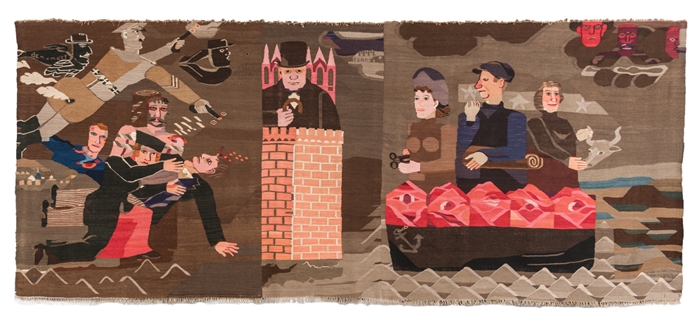That Hannah Ryggen’s tapestries have lately been the subject of renewed interest is not surprising, given that the self-taught Norwegian weaver used traditional techniques to deliver a personal take on the rise of fascism across Europe. Although she died almost half a century ago, her work combines the concerns of the present with the seductive appeal of lessons from the past.
One striking element of her large tapestries is the contrast between their ‘archaic’ look and the contemporaneity of their subject matter, as well as the freedom of composition they denote. In common with the traditions of Norwegian folk tapestry of the seventeenth and eighteenth centuries, the illusion of perspective is absent, with events and characters collapsing onto the picture plane. The structure, instead, stems from large blocks of colours and geometrical patterns, which create a visual hierarchy between the various elements depicted. The large friezelike 6 October 1942 (1943) resembles a triptych, across which a dreamlike narrative unfolds: on the left, Adolf Hitler is seen shooting Henry Gleditsch, the director of the Trøndelag Theatre, as oak leaves – a symbol of the Third Reich – come out of the dictator’s buttocks, while Winston Churchill watches from a tower at the centre of the composition; on the right Ryggen and her family (the artist becomes recognisable as a recurring character in the works) appear on a boat amidst tumultuous waters, perhaps attempting to escape.
Other compositions are even more radically segmented, becoming semiabstract. Ethiopia (1935), originally presented at the 1937 World Expo in Paris, was made in reaction to Mussolini’s invasion of Ethiopia in 1935, and is divided into two horizontal planes. The upper third is divided into a succession of vignettes, in which appear successively a black man, a white coloniser, Emperor Haile Selassie and another black figure brandishing Mussolini’s head on a spear. Black raised hands reappear throughout the various scenes, echoing the vertical motifs that occupy the lower two thirds of the composition. A similar composition arises in the sombre Death of Dreams (1936). At the centre, a man (Nobel Peace Prize-winner Carl von Ossietzky, we learn from the exhibition handout) is about to be executed by red-faced Nazi officers, while prisoners, depicted in white, witness the scene from behind bars. Five vertical rows of swastikas, outlined in grey and dark brown, gloomily occupy the lower part of the composition.
The more domestic We and Our Animals (1934) reveals the artist and her family’s daily life on the farm outside Trondheim where they lived. Ryggen worked on a loom built by her husband, carded and spun the wool from her sheep and concocted her own dyes from plants and, famously, urine to obtain the royal blue that recurs in many of her works. Despite her apparent isolation from the currents of global politics, Ryggen was moved to speak to the international struggle of the oppressed, to weave herself into the larger political tapestry and present it to the world (at the Paris World Expo, the Venice Biennale in 1964 or in front of her house, in Nazi-occupied Norway). Here the personal and the political are, both literally and figuratively, entwined – a galvanising example in these times of heightened individualism and nationalistic discourses.
Hannah Ryggen: Woven Histories at Modern Art Oxford, 11 November – 18 February 2018
From the April 2018 issue of ArtReview
